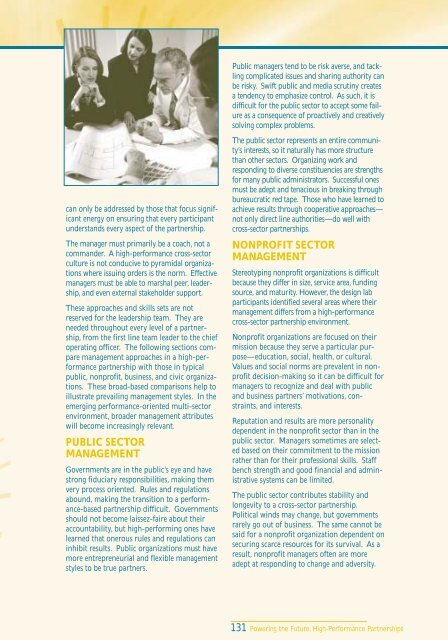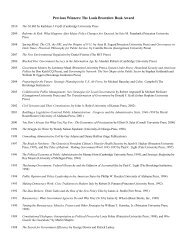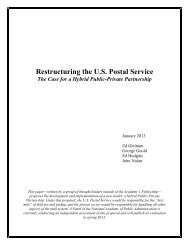High-Performance Partnerships - National Academy of Public ...
High-Performance Partnerships - National Academy of Public ...
High-Performance Partnerships - National Academy of Public ...
Create successful ePaper yourself
Turn your PDF publications into a flip-book with our unique Google optimized e-Paper software.
<strong>Public</strong> managers tend to be risk averse, and tackling<br />
complicated issues and sharing authority can<br />
be risky. Swift public and media scrutiny creates<br />
a tendency to emphasize control. As such, it is<br />
difficult for the public sector to accept some failure<br />
as a consequence <strong>of</strong> proactively and creatively<br />
solving complex problems.<br />
can only be addressed by those that focus significant<br />
energy on ensuring that every participant<br />
understands every aspect <strong>of</strong> the partnership.<br />
The manager must primarily be a coach, not a<br />
commander. A high-performance cross-sector<br />
culture is not conducive to pyramidal organizations<br />
where issuing orders is the norm. Effective<br />
managers must be able to marshal peer, leadership,<br />
and even external stakeholder support.<br />
These approaches and skills sets are not<br />
reserved for the leadership team. They are<br />
needed throughout every level <strong>of</strong> a partnership,<br />
from the first line team leader to the chief<br />
operating <strong>of</strong>ficer. The following sections compare<br />
management approaches in a high-performance<br />
partnership with those in typical<br />
public, nonpr<strong>of</strong>it, business, and civic organizations.<br />
These broad-based comparisons help to<br />
illustrate prevailing management styles. In the<br />
emerging performance-oriented multi-sector<br />
environment, broader management attributes<br />
will become increasingly relevant.<br />
PUBLIC SECTOR<br />
MANAGEMENT<br />
Governments are in the public’s eye and have<br />
strong fiduciary responsibilities, making them<br />
very process oriented. Rules and regulations<br />
abound, making the transition to a performance-based<br />
partnership difficult. Governments<br />
should not become laissez-faire about their<br />
accountability, but high-performing ones have<br />
learned that onerous rules and regulations can<br />
inhibit results. <strong>Public</strong> organizations must have<br />
more entrepreneurial and flexible management<br />
styles to be true partners.<br />
The public sector represents an entire community’s<br />
interests, so it naturally has more structure<br />
than other sectors. Organizing work and<br />
responding to diverse constituencies are strengths<br />
for many public administrators. Successful ones<br />
must be adept and tenacious in breaking through<br />
bureaucratic red tape. Those who have learned to<br />
achieve results through cooperative approaches—<br />
not only direct line authorities—do well with<br />
cross-sector partnerships.<br />
NONPROFIT SECTOR<br />
MANAGEMENT<br />
Stereotyping nonpr<strong>of</strong>it organizations is difficult<br />
because they differ in size, service area, funding<br />
source, and maturity. However, the design lab<br />
participants identified several areas where their<br />
management differs from a high-performance<br />
cross-sector partnership environment.<br />
Nonpr<strong>of</strong>it organizations are focused on their<br />
mission because they serve a particular purpose—education,<br />
social, health, or cultural.<br />
Values and social norms are prevalent in nonpr<strong>of</strong>it<br />
decision-making so it can be difficult for<br />
managers to recognize and deal with public<br />
and business partners’ motivations, constraints,<br />
and interests.<br />
Reputation and results are more personality<br />
dependent in the nonpr<strong>of</strong>it sector than in the<br />
public sector. Managers sometimes are selected<br />
based on their commitment to the mission<br />
rather than for their pr<strong>of</strong>essional skills. Staff<br />
bench strength and good financial and administrative<br />
systems can be limited.<br />
The public sector contributes stability and<br />
longevity to a cross-sector partnership.<br />
Political winds may change, but governments<br />
rarely go out <strong>of</strong> business. The same cannot be<br />
said for a nonpr<strong>of</strong>it organization dependent on<br />
securing scarce resources for its survival. As a<br />
result, nonpr<strong>of</strong>it managers <strong>of</strong>ten are more<br />
adept at responding to change and adversity.<br />
131 Powering the Future: <strong>High</strong>-<strong>Performance</strong> <strong>Partnerships</strong>









